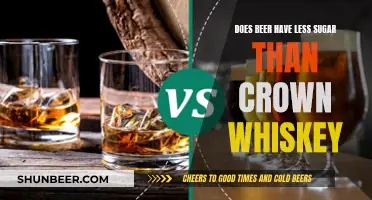
Beer is a popular alcoholic beverage made from yeast, grains, spices, and water. While sugar is not added to the ingredient list, it is naturally created when the grains are processed and fermented by yeast. The amount of sugar in beer depends on several factors, including its gravity, the type of yeast used, and any additional flavours such as honey or corn syrup. Beer typically contains a mix of 80% fermentable sugars and 20% oligosaccharides, a type of carbohydrate. Although beer has a low sugar content, it is high in carbohydrates, which the body can convert into sugar. Therefore, beer should be consumed in moderation, especially for those watching their sugar intake.
What You'll Learn
- Beer is made from yeast, grains, spices, and water
- Sugar is created when grains are processed and fermented by yeast
- Beer contains carbohydrates, which can raise blood sugar levels
- Beer styles vary in sugar content, with stouts and IPAs tending to have higher levels
- Non-alcoholic beer has a higher sugar content than alcoholic beer

Beer is made from yeast, grains, spices, and water
Beer is made from four primary ingredients: yeast, grains, spices, and water.
Yeast is the "magic ingredient" that converts sugars into carbonation, alcohol, and flavours. The yeast metabolises the sugars extracted from grains, which then produces alcohol and carbon dioxide. There are two major categories of brewing yeast: ale yeast and lager yeast. Ale yeast has a higher alcohol tolerance than lager yeast, so ales generally have a higher alcohol content and lower sugar content.
Grains are the second key ingredient in beer. The most common grain used is malted barley, although wheat, maize (corn), rice, and oats are also used. The grains are soaked in water, germinated, and then dried. This process, known as malting, helps to break down complex carbohydrates into simple sugars, which are more easily fermentable by yeast. The grains give beer its malt flavour and aroma, colour, and act as a fermentable material or "food for the yeast".
Spices, specifically hops, are the third ingredient in beer. Hops provide beer with a piquant aroma, a variety of flavours, and bitterness that balances the sweetness of the malt. Hops contain several characteristics that brewers desire in beer, including bitterness, floral, citrus, and herbal aromas and flavours. They also have an antibiotic effect that inhibits the growth of undesirable microorganisms.
Water is the main ingredient in beer, accounting for about 93% of its weight. The type of water used will make a difference in the flavour and quality of the beer. Different water sources have varying mineral contents, which can affect the taste of the beer. For example, Dublin's hard water is well-suited for making stouts, while the Plzeň Region's soft water is ideal for brewing Pilsner.
Best Low-Sugar Beers: The Sweetness Spectrum
You may want to see also

Sugar is created when grains are processed and fermented by yeast
Beer is made from grains, spices, yeast, and water. While sugar is not added to the mix, it is created naturally when the grains are processed and fermented by yeast.
The first step in the beer-making process is malting, where barley grains are soaked in water, germinated, and dried. This malting process helps break down complex carbohydrates into simple sugars like glucose, which are more easily fermented by yeast.
During the mashing stage, the germinated grains are roasted, milled, and soaked in hot water to create a sugar-containing liquid called wort. The wort is then boiled with hops or other spices, cooled, and filtered to remove plant residue.
Once the wort is prepared, yeast is added to begin the fermentation process. Yeast enzymes convert sugars into alcohol and carbon dioxide through fermentation. Specifically, yeast ferments simple sugars like glucose and fructose during fermentation, while some residual complex sugars remain, giving the final beer product its characteristic sweetness.
The final stage of beer-making is maturation, where the beer is stored and left to age.
In summary, sugar is created when grains, particularly barley, are processed through malting and mashing, and then fermented by yeast to produce alcohol and carbon dioxide. This natural process of sugar creation and fermentation determines the final alcohol content and sweetness of the beer.
Sour Beers: High Sugar Content or Healthy Choice?
You may want to see also

Beer contains carbohydrates, which can raise blood sugar levels
Beer is generally made from yeast, grains, spices, and water. While sugar is not added as an ingredient, it is created naturally when the grains are processed and fermented by yeast. This process is known as beer gravity, which refers to the density of the liquid extracted from the mashing process during brewing, known as the wort. When the wort has a lot of sugar, it is called a high-gravity wort.
Once yeast is introduced, the sugar content decreases while the alcohol content increases. After fermentation, beer typically comprises 80% fermentable sugars and 20% oligosaccharides, a type of carbohydrate. Beer's final sugar content depends on its gravity, the type of yeast used, and any additional flavours included, such as honey or corn syrup.
Beer contains varying amounts of carbohydrates, which can be converted into sugar by the body. These carbohydrates can potentially spike blood sugar levels. Alcohol in beer may also lead to low blood sugar, so it is important to monitor your levels if you are watching your sugar intake.
The amount of sugar in beer depends on the type and brand. Light beers tend to have slightly more sugar than regular beers due to differences in their fermentation process. However, non-alcoholic beers have the highest sugar content as none of the wort's sugar is converted into alcohol.
While beer may not have a high sugar content, it is still a significant source of calories. It is recommended to consume alcohol in moderation and to pair it with a carbohydrate-containing meal to maintain blood sugar balance.
Beer Sugar Content: Is It Really That High?
You may want to see also

Beer styles vary in sugar content, with stouts and IPAs tending to have higher levels
Beer contains varying amounts of sugar, depending on the style of beer and the brewing method. Beer styles vary in sugar content, with stouts and IPAs tending to have higher levels.
The sugar content in beer is created during fermentation, where yeast converts sugars from malted grains into alcohol. The amount of sugar in beer depends on several factors, including the type of yeast, the initial sugar concentration, and any additional flavourings such as honey or corn syrup.
Stouts, for example, tend to have higher sugar levels than other beers. This is because stouts are heavier, malty beers with a higher concentration of sugars in the wort. IPAs, or India Pale Ales, also tend to have higher sugar content due to the use of hops, which contribute to the floral taste of these beers.
The sugar content in beer is typically measured through "beer gravity," which refers to the density of the wort (the liquid extracted from the mashing process) relative to water at various stages of fermentation. A wort with a high sugar concentration is called a "high gravity wort." As yeast ferments the wort, the sugar content decreases while the alcohol content increases, resulting in a beer with a higher alcohol content.
It's important to note that the sugar content in beer is generally very low, and beer is not required by law to be labelled with its sugar content. However, for individuals with health concerns such as diabetes or hypoglycemia, understanding the sugar content of different beer styles is crucial.
Sugar Secrets: Priming Beer with Precise Sugar Grams
You may want to see also

Non-alcoholic beer has a higher sugar content than alcoholic beer
Beer is generally made from yeast, grains, spices, and water. Sugar is not added as an ingredient, but it is produced naturally when the grains are processed and fermented by yeast. The sugar content of beer depends on several factors, including its gravity, the type of yeast used, and any additional flavors included, such as honey or corn syrup.
Non-alcoholic beer tends to have a higher sugar content than its alcoholic counterpart. This is because, during the fermentation process, sugar is converted into alcohol. Therefore, in non-alcoholic beers, the sugar is not converted, resulting in a higher sugar content. It is important to note that the sugar amounts in non-alcoholic beers are still relatively low.
For example, Coors Non-Alcoholic beer contains 12.2 grams of carbohydrates and 8 grams of sugar per 355ml serving, while the alcoholic version, Coors Light, contains 5 grams of carbohydrates and 1 gram of sugar per 355ml serving. Similarly, Heineken's non-alcoholic beer contains 4.5 grams of carbohydrates and 1.3 grams of sugar per 100ml, while their alcoholic lager contains 11.4 grams of carbohydrates and no sugar per 355ml.
The higher sugar content in non-alcoholic beers is often due to the addition of sugar to improve the taste, as the absence of fermentation and alcohol can affect the flavor. However, it is worth noting that non-alcoholic beers still have lower calorific content than alcoholic beers, with an average of 37 calories per 100ml compared to 42 calories per 100ml in alcoholic beers.
While the sugar content in non-alcoholic beers may be higher, it is still relatively low compared to other beverages. For instance, the average cola drink contains around 10.6 grams of sugar per 100ml, which is significantly more than most non-alcoholic beers. Additionally, non-alcoholic beers offer several health benefits, such as improved sleep, reduced anxiety, and lower long-term health risks associated with alcohol consumption.
Beer and Sugar: The Breakdown Process Explained
You may want to see also
Frequently asked questions
Yes, beer contains sugar. The sugar content depends on the type of beer and the ingredients used.
The amount of sugar in beer varies depending on the brand and type. Light beers tend to have slightly more sugar than regular beers. Non-alcoholic beers have the highest sugar content.
Beer generally has less sugar than other alcoholic drinks like wine and cocktails. However, it contains carbohydrates, which the body can turn into sugar.
Sugar is created during the fermentation process when sugars from malted grains are converted into alcohol. The sugar content also depends on the type of yeast and additional flavours used.
Beer has a relatively low sugar content, but it contains carbohydrates that can affect blood sugar levels. If you're monitoring your sugar intake, it's best to consume beer in moderation and check the nutritional information for specific brands.







